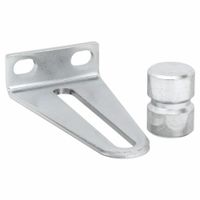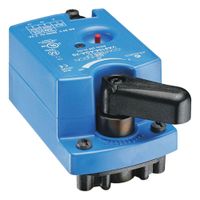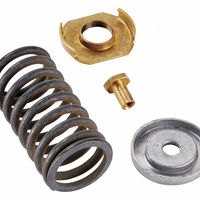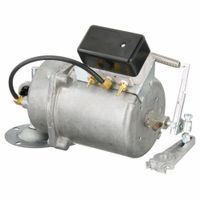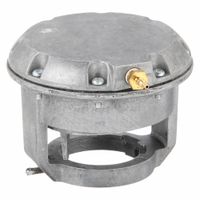Call +(254) 703 030 000 / 751 483 999 / 721 704 777
- Home
- Hvac And Refrigeration
- Hvac Controls And Thermostats
- Actuators For Hvac Dampers Valves
.....Read More
Frequently Asked Questions
What is the difference between electric and pneumatic actuators for dampers and valves?
Electric actuators use electrical energy to create motion, while pneumatic actuators use compressed air.
Electric actuators are precise, offering fine control over position and speed, making them suitable for applications requiring accurate adjustments. They are quieter, require less maintenance, and are ideal for environments where a clean operation is necessary. However, they can be more expensive and slower in response compared to pneumatic actuators.
Pneumatic actuators, on the other hand, are faster and can generate high force outputs, making them suitable for applications requiring quick and powerful movements. They are generally more cost-effective and can operate in hazardous environments due to their simple design and fewer electrical components. However, they require a constant supply of compressed air, which can lead to higher operational costs and maintenance of the air supply system.
In summary, the choice between electric and pneumatic actuators depends on factors like precision, speed, cost, maintenance, and environmental conditions.
How do electric HVAC damper actuators work?
Electric HVAC damper actuators are devices used to control the position of dampers in heating, ventilation, and air conditioning systems. They work by converting electrical energy into mechanical motion to open, close, or modulate the position of a damper, which regulates airflow within the system.
The operation begins with a control signal, typically from a thermostat or building management system, which dictates the desired position of the damper. This signal can be analog (e.g., 0-10V or 4-20mA) or digital (e.g., Modbus, BACnet).
Upon receiving the control signal, the actuator's motor is activated. The motor is usually a small electric motor that drives a series of gears. These gears amplify the motor's torque, allowing it to move the damper blade to the required position. The actuator may use a direct drive mechanism or a linkage system to connect to the damper shaft.
To ensure precise control, many actuators are equipped with position feedback systems. These systems use potentiometers, encoders, or other sensors to monitor the damper's position and provide feedback to the control system. This feedback allows for accurate positioning and modulation of the damper, ensuring optimal airflow and energy efficiency.
Some advanced actuators also feature spring-return mechanisms, which automatically return the damper to a default position in the event of a power failure, ensuring safety and maintaining system balance.
Overall, electric HVAC damper actuators play a crucial role in maintaining indoor air quality, comfort, and energy efficiency by precisely controlling airflow within HVAC systems.
What are the benefits of using pneumatic actuators in HVAC systems?
Pneumatic actuators offer several benefits in HVAC systems:
1. **Reliability and Durability**: Pneumatic actuators are known for their robust construction, making them highly reliable and durable. They can withstand harsh environmental conditions, including dust, moisture, and temperature fluctuations, which are common in HVAC applications.
2. **Safety**: Pneumatic systems are inherently safe as they do not produce sparks, making them suitable for use in potentially explosive environments. This is particularly important in HVAC systems that may be installed in industrial settings.
3. **Cost-Effectiveness**: Pneumatic actuators are generally less expensive to purchase and maintain compared to their electric counterparts. The simplicity of their design leads to lower initial costs and reduced maintenance expenses over time.
4. **Simplicity and Ease of Use**: These actuators are simple to install and operate. They require minimal training for personnel, which can lead to reduced labor costs and quicker implementation in HVAC systems.
5. **Fast Response Time**: Pneumatic actuators provide quick response times, which is crucial for maintaining precise control over HVAC systems. This rapid actuation helps in achieving desired temperature and airflow conditions efficiently.
6. **Energy Efficiency**: While pneumatic systems require a constant supply of compressed air, they can be more energy-efficient in certain applications, especially where rapid cycling is needed. The energy used in compressing air can be offset by the efficiency gains in system performance.
7. **Modularity and Scalability**: Pneumatic actuators can be easily integrated into existing HVAC systems and scaled up or down as needed. This flexibility allows for easy upgrades and modifications to the system.
8. **Wide Range of Applications**: They are versatile and can be used in various HVAC applications, including controlling dampers, valves, and other components, making them a versatile choice for system designers.
How do you select the right actuator for a specific valve or damper?
To select the right actuator for a specific valve or damper, consider the following factors:
1. **Type of Valve/Damper**: Identify whether it's a ball, butterfly, globe valve, or a damper. Each type may require a different actuator type.
2. **Torque Requirements**: Determine the torque needed to operate the valve or damper. This depends on the size, type, and pressure conditions. Ensure the actuator can provide sufficient torque to overcome static and dynamic forces.
3. **Actuation Method**: Decide between electric, pneumatic, or hydraulic actuators based on available power sources, control precision, and environmental conditions.
4. **Control Type**: Choose between on/off, modulating, or proportional control based on the application requirements. Modulating actuators provide variable positioning, while on/off actuators are for simple open/close operations.
5. **Speed of Operation**: Consider how quickly the valve or damper needs to open or close. Some applications require rapid actuation, while others may need slower, more controlled movements.
6. **Environmental Conditions**: Assess the operating environment, including temperature, humidity, and exposure to corrosive substances. Select an actuator with appropriate ingress protection (IP) ratings and materials.
7. **Power Supply**: Ensure compatibility with available power sources, such as AC or DC voltage for electric actuators, or air supply for pneumatic actuators.
8. **Size and Weight**: Ensure the actuator fits within the available space and that the mounting structure can support its weight.
9. **Safety and Compliance**: Check for compliance with industry standards and safety requirements, such as fail-safe features or explosion-proof ratings if necessary.
10. **Cost and Maintenance**: Consider the initial cost, as well as long-term maintenance and operational costs. Choose an actuator that balances performance with budget constraints.
By evaluating these factors, you can select an actuator that meets the specific needs of your valve or damper application.
What maintenance is required for electric and pneumatic actuators?
Electric actuators require regular inspection of electrical connections to ensure they are secure and free from corrosion. Check for any signs of wear or damage in the wiring and connectors. Lubricate moving parts as specified by the manufacturer to prevent friction and wear. Inspect the actuator housing for any physical damage or signs of moisture ingress, which could affect performance. Verify the calibration and alignment of the actuator to ensure accurate positioning. Test the actuator's performance periodically to ensure it operates within the specified parameters.
Pneumatic actuators require regular inspection of air supply lines for leaks or blockages. Ensure that the air supply is clean and dry, as moisture or contaminants can damage internal components. Check the actuator seals and diaphragms for wear or damage, replacing them as necessary to prevent air leaks. Lubricate moving parts with appropriate lubricants to reduce friction and wear. Inspect the actuator housing for physical damage and ensure all fasteners are secure. Verify the calibration and alignment of the actuator to ensure accurate operation. Test the actuator's performance regularly to ensure it responds correctly to control signals.
Both types of actuators benefit from a scheduled maintenance program that includes regular testing and inspection to identify potential issues before they lead to failure. Proper documentation of maintenance activities is essential to track the actuator's condition and performance over time.
How do control signals affect the operation of HVAC actuators?
Control signals are crucial in determining the operation of HVAC (Heating, Ventilation, and Air Conditioning) actuators, which are devices responsible for moving or controlling a mechanism or system. These signals dictate the behavior of actuators, influencing the overall performance and efficiency of HVAC systems.
1. **Types of Control Signals**: Control signals can be analog or digital. Analog signals, such as 0-10V or 4-20mA, provide a continuous range of values, allowing for precise control of actuator positions. Digital signals, often in the form of binary on/off commands or more complex protocols like Modbus or BACnet, enable discrete control and communication with building management systems.
2. **Modulation**: Control signals modulate the actuator's position or speed. For example, in a variable air volume (VAV) system, a control signal might adjust a damper actuator to regulate airflow based on the desired temperature or air quality. This modulation ensures that the HVAC system responds dynamically to changing environmental conditions and occupancy levels.
3. **Feedback Mechanism**: Many actuators provide feedback signals to the control system, indicating their current position or status. This feedback allows for closed-loop control, where the system can make real-time adjustments to maintain desired conditions, enhancing accuracy and reliability.
4. **Energy Efficiency**: Proper control signal management can significantly improve energy efficiency. By precisely controlling actuators, HVAC systems can minimize energy consumption while maintaining comfort levels, reducing operational costs and environmental impact.
5. **System Integration**: Control signals facilitate integration with other building systems, enabling coordinated operation. For instance, an HVAC system can adjust based on inputs from lighting or security systems, optimizing overall building performance.
In summary, control signals are vital for the precise and efficient operation of HVAC actuators, impacting system responsiveness, energy efficiency, and integration with broader building management systems.
What accessories are available for electric and pneumatic HVAC actuators?
Electric and pneumatic HVAC actuators can be equipped with a variety of accessories to enhance their functionality, control, and integration within HVAC systems.
1. **Positioners**: These devices ensure the actuator reaches the desired position accurately. They can be mechanical, electro-pneumatic, or digital, providing precise control over valve or damper positions.
2. **Feedback Devices**: Potentiometers or encoders provide position feedback to the control system, allowing for monitoring and adjustments. This is crucial for systems requiring precise control and monitoring.
3. **Limit Switches**: These are used to signal when an actuator has reached a specific position, providing safety and operational feedback to the control system.
4. **Manual Override**: This feature allows manual operation of the actuator in case of power failure or during maintenance, ensuring continued operation or safe shutdown.
5. **Mounting Brackets and Linkages**: These accessories are essential for proper installation, ensuring the actuator is securely attached to the valve or damper.
6. **Weatherproof Enclosures**: For outdoor or harsh environments, enclosures protect actuators from dust, moisture, and other environmental factors.
7. **Speed Controls**: These devices adjust the speed of actuator movement, which can be critical for applications requiring slow or controlled motion.
8. **Solenoid Valves**: In pneumatic systems, solenoid valves control the air supply to the actuator, enabling remote operation and integration with control systems.
9. **Position Transmitters**: These devices convert the actuator's position into a standard signal (e.g., 4-20 mA) for remote monitoring and control.
10. **Spring Return Mechanisms**: These ensure the actuator returns to a default position in case of power or signal loss, providing a fail-safe operation.
11. **Communication Modules**: For integration into building management systems, these modules enable communication via protocols like BACnet, Modbus, or LonWorks.
These accessories enhance the performance, reliability, and integration of HVAC actuators within complex systems.
